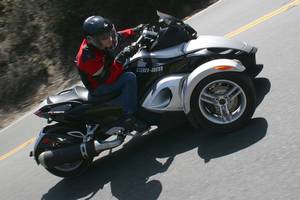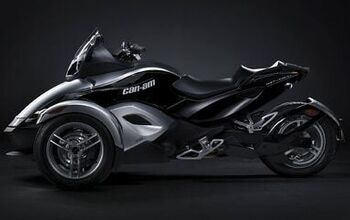2008 Can-Am Spyder Test - Motorcycle.com
First off, yes, we MOrons understand the Can-Am Spyder isn’t a motorcycle. And, as such, it might not seem to belong on a Motorcycle.com website.
But regardless of its non-single-track layout, it does have plenty of motorcycle guts and the thrill of the wind in your face, so we had to give it a ride.
Or, instead, does one give the Spyder a drive? Although there is no car-like steering wheel, there is a pair of wheels up front, which has the side result of making California-type lane-splitting quite problematic. No matter. We at MO know what to do with a handlebar.
Well, those of us with experience on a snowmobile do. Sitting on the Spyder’s expansive seats feels akin to straddling a Ski-Doo, a popular brand of snow machine manufactured by Bombardier Recreational Products (BRP), also the parent company of Can-Am.
The Can-Am name is familiar to motorcyclists who were around during the 1970s and didn’t take Hunter S. Thompson-levels of hallucinogens. Emerging in 1972, Can-Am’s motocrossers were some of the fastest rigs available. But by 1982, the brand dried up and remained dormant until being resurrected by BRP for Bombardier’s 2007 ATV lineup. And now, along comes the Spyder.
We’re all familiar with motorcycle-based trikes. Not much more than a solid rear axle and two rear wheels bolted to a Goldwing or Electra Glide, right? Well, this trike ain’t anything like that.
The Can-Am Spyder sits only 45.1 inches tall, which promises sports-car handling, and its wheel pair is at the front rather than the rear. This makes for quite a different animal.
Up front, the Spyder uses a double A-arm front suspension that offers 5.7 inches of travel to the pair of 14-inch wheels. An anti-roll bar limits the amount of undesirable lean when cornering. The rear end uses a single shock on a conventional swingarm, with an aluminum 15 x 7-inch wheel holding an automotive-type 225/50 rear tire.
It all adds up to Can-Am’s trademarked tagline of “the Y factor,” in reference to the shape of the Spyder’s wheel arrangement if viewed from above. “It resides beyond the conventions of motorcycles and automobiles,” reads the brochure copy. “Combining the best of two- and four-wheeled rides, laced with the thrill of off-road powersports. And it all begins at the end of your driveway.” As flowery and hyperbolic as the above text might be, it actually sums up the Spyder riding experience rather well. It offers a truly unique riding experience, and one that feels almost illegal when among traditional traffic.
The Spyder ain’t a car and it ain’t a bike, and if you’re looking for the core qualities of either, you might be disappointed. But if you’re in the market for a fun-yet-unintimidating ride, Can-Am’s new roadster might be right up your alley.
Be sure to bring a sense of fun to the table, as the Spyder is sure to elicit plenty of grins from its adventurous owners. It’s a responsive and thrilling sports car minus a fourth wheel. The only ones who might be disappointed after a ride on the Spyder are die-hard motorcycle snobs who are dismissive of anything that doesn’t lean into corners like a proper single-track vehicle. But the lack of leaning inward while turning doesn’t have to hinder the arousal, just as Cindy Crawford’s mole doesn’t spoil the overall picture.
Any Gixxer-loving 20-something who writes a letter complaining about the waste of space the Spyder takes in a motorcycle website is missing the point. Sure, you’re probably faster than Vale Rossi and it’s but an oversight that sees you without a factory contract, but there are many riders out there who are less physically able to handle your bitchin’ GSX-R or the weight of an 800-lb cruiser, whether a physically challenged war vet or a petite woman.
Which brings us back to the big idea from Can-Am. Why require an owner to be able to heft his big scooter off its sidestand or, worse, from its side after a tip-over? The addition of a third wheel instantly removes a motorcycle’s biggest intimidation factor. I wouldn’t even entertain the idea of unleashing my wife on an Aprilia RSV1000 sportbike, but she could probably handle the less-taxing requirements of riding the Spyder with a very similar engine. And if you’re disabled, weak or tentative, this trike can be a nice bridge to the world of motorcycling.
So there’s the preamble. Hop aboard and there’s much that’s familiar to MO users. Instruments feature twin circular faces that include readouts for fuel, twin tripmeters, engine temp, ambient temp and gear position. Can-Am’s Digitally Encoded Security System ensures the Spyder fires up only with the correctly coded electronic key.
Thumb the starter button and you’ll hear the staccato rumble from a variation of Aprilia’s V-Twin, both of which are manufactured by Rotax, a subsidiary of BRP. The fuel-injected mill has been retuned for additional torque and it trades a sixth gear for a reverse gear. Power is transmitted to the pavement via a carbon-reinforced drive belt.
Can-Am claims the 998cc motor pumps out 77 ft-lbs of torque at 6250 rpm, which is enough grunt to hurl the 697-pound (claimed, dry) machine down the road ahead of most any car. A little further up the tachometer at 8500 revs arrives the power peak of a claimed 106 ponies.
Getting going from a stop requires a fairly strong tug on the clutch lever, and it seems logical that some of those in the market for the Spyder would appreciate an automatic clutch like the Yamaha FJR1300AE. Can-Am will be offering a thumb-shift sequential electronic transmission as an option. In the manual version we tested, the Spyder scampers smoothly away thanks to an abundance of torque from the liter-size V-Twin. So it hauls some decent ass, but its notable performance occurs in the twisties. At nearly 60 inches wide, there is tremendous inherent stability in its tri-wheel design. For those who like to push dynamic limits (uh, all of us!), there are several computer systems employed to save us from ourselves.
Key among them is the Stability Control System. A computer or three takes info from the lateral and yaw sensors to determine if the rider is getting over his or her head. Wheel-speed sensors and the handlebar angle are figured into the equation, then the SCS brain can brake any of the wheels individually to regain control, augmented if necessary by a reduction in engine output. Similarly, the Traction Control System uses sophisticated circuitry to make sure the only donuts in the Spyder package are in the massive 44-liter under-hood storage compartment that is big enough for two full-face helmets. At least the electronic nannies allow for amusing tire-smoking launches in a straight line (see the accompanying video).
Stunters might want to do some disconnecting of the finger-wagging ECUs, but they still allow a fun and oddly satisfying scything of a curvy road. Yet another system, Dynamic Power Steering, keeps steering effort relatively light, and it varies according to vehicle speed and the forces put into the handlebar. The system works, offering immediate responses without twitchiness. And when you’re entering that corner, you’ll appreciate a muscular braking system that consists of four-piston calipers biting on 260mm discs at all three wheels. There is no hand lever, so you’ll want to get familiar with the foot pedal in the typical right-side location. Its high placement forces a rider to raise his foot before stomping on it, which isn’t ergonomically ideal. A parking brake is found near the left footpeg.
Can-Am says: “Spyder brings the active riding style commonly associated with off-road vehicles to the road. The result is an entirely new riding sensation on pavement.”
Can-Am says: “Spyder brings the active riding style commonly associated with off-road vehicles to the road. The result is an entirely new riding sensation on pavement.”
Fonz says: “Take your wife or daughter’s Miata and hop up on the roof and take a ride. If you could steer from that vantage, it would feel a little like a spin on the Spyder. Not for the height, but for the wide, road-gripping sensation one gets when piloting this three-wheeled roadster.”
We think the Spyder might make an interesting sport-tourer, what with its plush seats, voluminous stowage and generous 7.1-gallon fuel capacity. Among several options for the trike are travel bags (tank, passenger seat and luggage rack locations) and cargo liners, plus a passenger backrest, luggage rack and different-sized windshields. Other available options include: fog lights, xenon headlights, solo-seat cover and a “racing” exhaust pipe. Heated grips and seat would add to touring ability and be expected from a company that manufactures snowmobiles, but Can-Am doesn’t yet have them available. Can-Am reps hinted at some tweaks to future iterations of the Spyder, including a handlebar repositioned a bit further rearward and some revised bodywork to keep heat from coming off the right-side radiator and on to a rider’s foot. The relocated handlebar will make sense for those pilots who would rather cruise than rail. As for the heat issue, it wasn’t one for us.
Since we all didn’t get enough attention as children, we really enjoyed the rock-star levels of attention the Can-Am attracted – you can thrill an entire school bus of kids simply by riding past and giving a wave as you soar on by with this three-wheeler.
On the downside, lane-splitting traffic is impossible, parking a 105-inch-long vehicle in a crowded garage is problematic, and we think some of the plastic bodywork looks a bit down-market. So, although we’d never exchange a motorcycle for the Spyder, we were certainly entertained during our brief test of the ’tweener – not a bike and not quite a car. It offers a novel vehicular experience in a fun and attractive package. And, at $14,995 with a two-year warrantee, it’s reasonably priced.
Check it out for yourself at TrySpyder.com
Related Reading
2009 Can-Am Spyder SE5 Review
2008 Can-Am Spyder Review
John Cusack rides Can-Am Spyder across Ireland
More by Kevin Duke



































Comments
Join the conversation